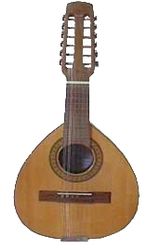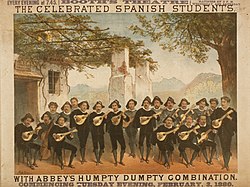Bandurria
 | |
| String instrument | |
|---|---|
| Classification | Plucked chordophone |
| Hornbostel–Sachs classification | 321.321 (Necked bowl lute) |
| Related instruments | |
| mandolin, mandore | |
The bandurria is a plucked chordophone from Spain, similar to the mandolin, primarily used in Spanish folk music, but also found in countries that were once colonies of Spain.
Instrument development
Prior to the 18th century, the bandurria had a round back, similar or related to the mandore.[1] It had become a flat-backed instrument by the 18th century, with five double courses of strings, tuned in fourths.[1] The original bandurrias of the Medieval period had three strings. During the Renaissance they gained a fourth string. During the Baroque period the bandurria had 10 strings (5 pairs).
The modern bandurria has 12 strings (6 pairs). The strings are tuned in unison pairs, going up in fourths from the low G#. The lowest four strings are a major-third above those of a standard guitar and the highest two strings are a fourth above a standard guitar, i.e. G♯, c♯, f♯, b, e and a.[2]
-
Bandurria (front view)
-
Bandurria (back view)
-
Bandurria (tailpeice)
-
Bandurria (tuning head)
Variations and uses in different parts of the world
Spain

Juan Ruiz first mentioned the term "mandurria" in the 14th century in his "Libro De Buen Amor." [5] After that, Juan Bermudo gave the description of the bandurria in his "Comiença el libro llamado declaraciõ de instrumentos" as a three-string instrument in 1555, but he also mentioned other types with four or even five strings. In the early 1870s, a child's wake was accompanied with the bandurria music in Jijona, Alicante Province. The zapateo, a dance derived from the Spanish zapateado and introduced by tobacco cultivators from the Canary Islands, is accompanied with bandurria and other instruments before 1900.
Philippines
The Philippine harp bandurria is a 14-string bandurria used in many Philippine folkloric songs, with 16 frets and shorter neck than the 12 string bandurria.[2] This instrument probably evolved in the Philippines during the Spanish period, from 1521 to 1898. The Filipino bandurria is used in an orchestra of plucked string instruments called rondalla. It is tuned a step lower than the Spanish version, that is, low to high: F# B E A D G.[6]
South America
There are also many different varieties of Bandurria in South America, especially Peru and Bolivia. They have 4 courses, unlike the traditional Spanish 6 courses.[2] The 4 courses are double, triple or quadruple, and the tuning is guitar-like, rather than the fourths tuning used on the Spanish type.[7] In Lima, Peru, harp and bandurria duos were common in the early 20th century. Nowadays people there still play bandurria accompanying with the popular vals peruano, or vals criollo.[5]
United Kingdom
Although generally little known in the UK, the bandurria was used by Roy Williamson of the Scottish folk-group The Corrie Folk Trio. When this group later (after the loss of one member) became the immensely popular Corries, Williamson incorporated a bandurria into one of the two multi-instrument "combolins" that he constructed for himself and his partner.
Notable players and music
- Javier Mas "Tamiz".[8]
- Arnel Pineda
See also
References
- ^ a b Tyler, James; Sparks, Paul (1992). The Early Mandolin. Oxford: Clarendon Press. p. 52. ISBN 0-19-816302-9.
- ^ a b c "B". Stringed Instrument Database. dusepo@dusepo.co.uk. Late updated 14 Sept 2013.
{{cite web}}:|access-date=requires|url=(help); Check date values in:|date=(help); Missing or empty|url=(help) - ^ "Death of Henry E. Abbey; The Well-Known Manager's Long Career Closed. The New York Times. October 18, 1896. Column 3".
- ^ Sparks 2003, p. 23–29
- ^ a b Schecter, John (2007). "Bandurria". Grove Music Online (Oxford Music Online ed.). Oxford University Press. Retrieved 30 Sep 2013.
- ^ http://stringedinstrumentdatabase.aornis.com/
- ^ "South America". ATLAS of Plucked Instruments. Retrieved 2014-02-22.
- ^ Mas and Rallo (Jun 15, 2000). Tamiz (MP3). 2000 Harmonia Mundi. ASIN B0018BUBNQ.
- Sparks, Paul (2003). The Classical Mandolin. Oxford: Oxford University Press. ISBN 9780195173376.




